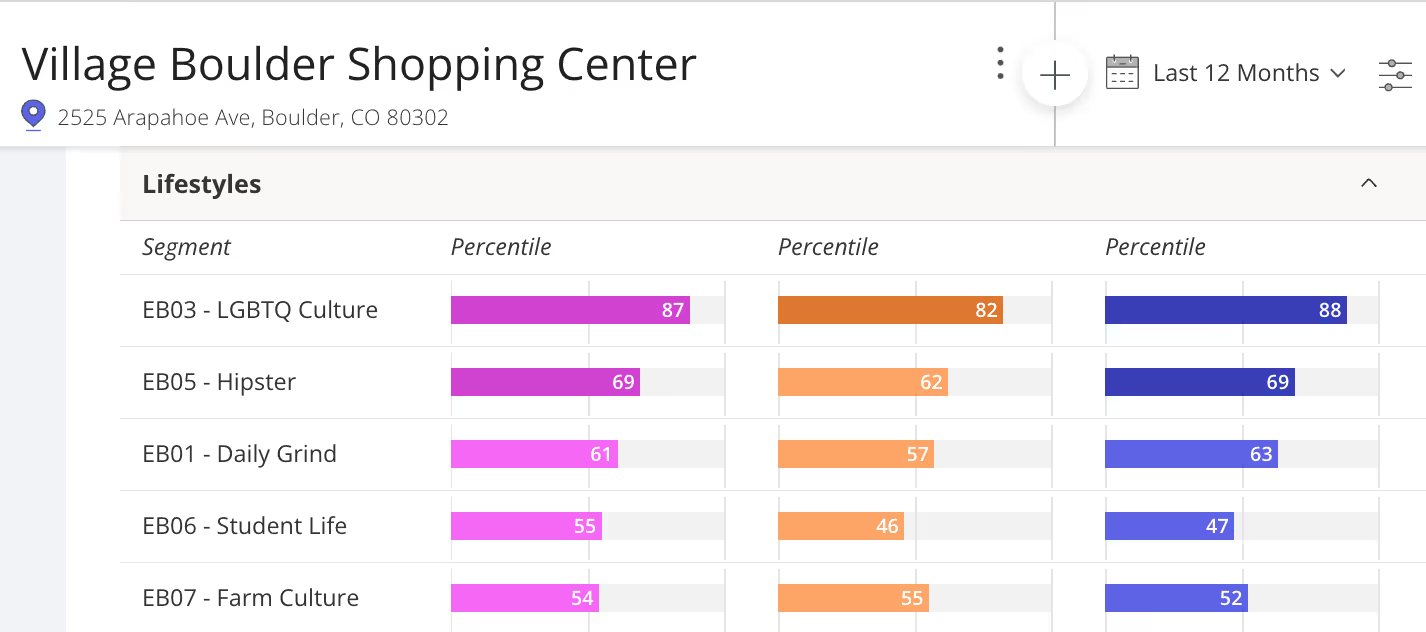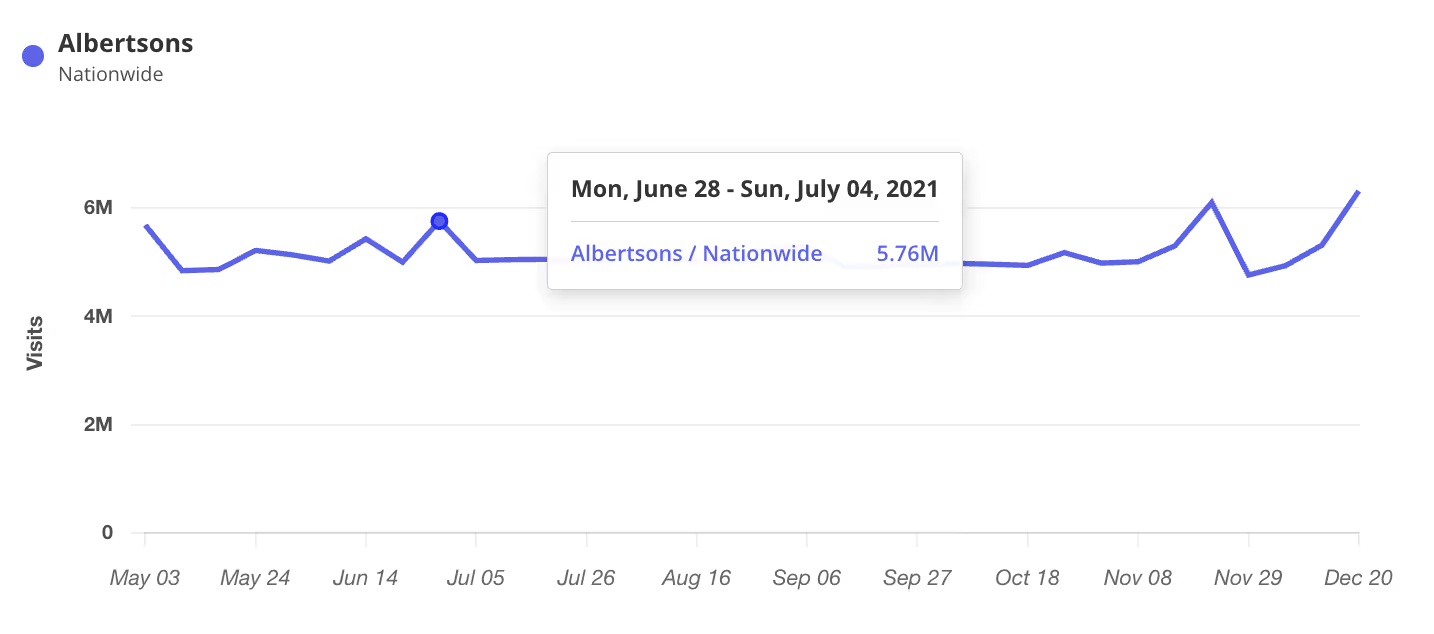Table of Contents
What is Location Intelligence for Advertising?
Location intelligence, also known as foot traffic or footfall data, draws on geospatial data points to analyze the movement of people from place to place. Advertising agencies and out-of-home-media companies can tap into these data points to achieve better personalization, improved targeting, and more accurate campaign measurement. By taking a data-driven approach to standard marketing practices – audience segmentation, site location, and reach – advertisers can create campaigns with precision.
Foot traffic data provides accurate insights into consumer behavior, including metrics such as hourly visits, customer loyalty, and demographic shifts within a business' trade area – based on aggregated, statistical information about how people move in the physical world. Advertisers can harness these data points to learn more about their target audience and hone messaging accordingly, ensuring a higher return on investment (ROI). Advertisers can also draw on location analytics to better measure physical impressions and evaluate offline audience engagement.
How Can Advertisers Use Trade Area Data to Optimize Advertising Spend?
Most location intelligence tools for advertisers use trade areas in some way. A trade area refers to the geographic region (which can be broken down by zip codes, census block groups (CBGs), etc) where most visitors to a given venue come from. Foot traffic data can reveal the trade areas of stores, billboard placements, shopping malls, and other commercial venues, which is critical for advertisers looking to reach specific audience segments efficiently. Location intelligence can also give agencies up-to-date and accurate information regarding the reach of out-of-home (OOH) advertising placements by uncovering the movement patterns of key audience segments.
By using trade area information in conjunction with other location analytics datasets, advertisers can gain unprecedented visibility into their target audience’s geographic distribution (on the zip-code or CBG level), commute patterns, spending habits, social media preferences, and a host of other key insights. This data can help both online and offline advertisers optimize their campaigns, improve conversions, and increase ROI.

Read on to learn eight ways advertisers can use location data to improve their offline marketing campaigns.
1. Choose the Most Effective Ad Locations
Marketers advertising brands in the brick-and-mortar space can optimize ad placements by using foot traffic data to understand where their target audience lives or commutes. External advertising agencies can use location analytics for valuable information about their client’s customer base without relying on the client’s first-party or CRM data. And location analytics can also help marketers identify the trade area of competitors’ venues, which opens new advertising opportunities and helps marketers focus their campaigns on high-intent audiences.
Foot traffic data can also reveal a target audience's favorite shopping areas and main travel routes, which helps marketers optimize their OOH advertising asset placement and increase their ROI. Instead of trying to reach as wide an audience as possible by placing ads in highly trafficked (and expensive) locations, location analytics allows advertisers to focus their campaigns on areas that actually attract their specific segments they’re looking to reach.
For example, one agency initially used the “ring method” – which involves drawing a 5-mile radius ring around a property – for identifying the geographic distribution of visitors to their client’s store. The agency then used location intelligence to identify the stores’ True Trade Area and found that the previous method had missed out on reaching a significant percentage of their audience.

2. Create Better Audience Segmentation
Location analytics can also reveal the characteristics and preferences of a business' target audience. Layering demographic and psychographic datasets onto foot traffic data provides visibility into the demographic and psychographic attributes of people in a given trade area. Brands and advertisers can use this data to segment their audience better – and a better audience segmentation will lead to more effective marketing and advertising.
A deeper understanding of these profiles assists marketing professionals in creating accurate audience segments based on metrics such as region, age, gender, and interests. Location intelligence also helps advertisers adapt their campaigns to an evolving consumer landscape. Advertisers can use location intelligence to identify relevant consumer profiles, preferences, consumer spending, and even social media behavior, allowing for increased precision when building a campaign. And advertisers can optimize campaign spend by using the Placer XTRA Targeted Search custom report to identify geographic regions where certain customer segments are overrepresented.
A campaign for a specialty coffee brand used location intelligence to find a shopping area that had a high concentration of both hipster culture and coffee and where visitors spent a lot of money at independent coffee shops. The agency then harnessed behavioral data to identify the regions where visitors to this shopping center were coming from, to aid in personalizing messaging accordingly. In the inverse, these datasets can highlight areas where there is little to no interest in artisanal coffee, allowing campaign managers to focus their efforts on more receptive audiences.

3. Advertise Offline with Precision
Digital out-of-home (DOOH) marketing, which focuses on digital screens, including billboards or ads in bus stops, building lobbies, and elevators, is on the rise. Programmatic DOOH campaigns offer an even more flexible approach to marketing and allows advertisers to tweak campaigns in real-time based on a multitude of data signals.
DOOH advertising is popular for many reasons, but one crucial benefit is its ability to plan ads based on the time of day a target audience is most likely to be reached. Foot traffic data can provide unprecedented insight into visit times by revealing hourly and daily fluctuations – advertisers can use foot traffic data to accurately pinpoint when a key demographic is most likely to pass by an ad. The time slots can then be adjusted accordingly to maximize reach for the campaign.
One company, seeking to reach as much of its target audience as possible, analyzed the hourly impressions for two road intersections in Denver, CO. It found that visits peaked at 7:30 AM and then again between 4 and 5 PM. To maximize their reach while cutting costs, the company ran ads from 7:30 AM to 8:30 AM, and from 3:30 PM to 5:30 PM, minimizing expenditures while maximizing reach.

4. Improve Efficiency of Direct Mail
While online advertising has revolutionized advertising, direct mail marketing (DMM) is still extremely popular – and effective. But with effective results hinging on mail reaching the correct mailboxes, and given that direct mail campaigns can be costly, finding and targeting the right audience is crucial.
Location data allows advertisers to map specific zip codes and hone their messaging to resonate with the intended demographics. These tools can also help eliminate distribution waste by identifying and avoiding the neighborhoods least receptive to a product.
For example, a California-based direct mail marketing company saw its most successful first quarter ever when it used Placer.ai’s data to refine customer segments. The company saw a significant increase in coupon redemption by accurately identifying the areas from which it was most likely to draw customers. These impressive results are not limited to offline reach, either – data-driven insights into online customer segmentation are just as valuable when planning a digital ad campaign.

5. Increase Customer Loyalty and Retention Offline
Customer loyalty contributes substantially to revenue growth, and maintaining good relationships with existing customers is essential. Loyal customers are more likely to suggest a brand to friends or family, increasing marketing reach with no additional investment.
Leveraging foot traffic data can help advertisers identify where casual and loyal customers come from and hone messaging to those segments accordingly. One way to measure customer loyalty is to examine the change in trade areas over time, showing where customers have increased or reduced the frequency of their visits. An increase in visit frequency implies greater loyalty, while lowered frequency suggests the opposite. In the case of lowered frequency, campaigns can target these once-loyal customers with promotions and deals to increase their visit frequency.

6. Make an Impact with Any Budget
Foot traffic data allows advertisers to build their campaigns with maximum precision. A campaign focused on targeting the right audience can lead to a more significant impact with less advertising spend. And advertisers working with a limited budget can target messaging on channels where they can reach the most relevant audiences.
The Placer.ai Marketplace offers a wide range of behavioral, demographic, psychographic, and other datasets. When combined with foot traffic data, these datasets can provide advertisers with valuable insights into a target audience's likes, dislikes, and preferred media channels. An agency looking to effectively reach a consumer segment can utilize these metrics to learn not only where they like to shop offline, but which websites they prefer. Harnessing this psychographic data can help advertisers narrow marketing efforts and find the best platforms to reach buyers.
7. Better Target Online Campaigns
Digital and offline media target audiences in different ways. Offline media can reach large swaths of potential customers, while digital media typically allows advertisers to target more specific audiences.
Digital media campaigns tend to segment the target audience based on data from social platforms and the brand’s first-party data. But relying on these data points is not so straightforward – changes in privacy norms can reduce companies’ visibility into their target audience’s online behavior, and normalizing information from disparate sources can be a real challenge. Smaller companies with fewer customers available to provide information are also at a disadvantage. The challenge for agencies is particularly acute, as many clients may be reluctant to share their first party data.
Placer’s location data can be used to help advertisers validate and refine the audience segments identified and can help increase the accuracy of geofencing by ad serving tools, demand-side platforms (DSPs), or tag managers. One strategy consultancy uses Placer to provide insights into their customers, determining metrics such as loyalty, most visited locations, and typical visitor journey.
8. Measure OOH Performance and Prove ROI
Quantifying impressions for offline and OOH media is not a simple task, and measuring impact can be a real challenge. In the digital world, online platforms often feature built-in tracking metrics to help qualify campaign performance – but measuring the impressions of “traditional” media channels, such as OOH placements, is still difficult. And the problem is even more acute for marketers looking to prove the effectiveness of their ad campaigns in driving business outcomes.
Foot traffic data can provide unbiased data sources to demonstrate impressions and efficacy of offline advertising efforts. Advertisers can see the number of generated impressions from an OOH ad, compare visitation to the advertised brand’s venues before and after a campaign, or benchmark against past initiatives to evaluate a campaign’s impact. Location intelligence can also help advertisers understand the impact online campaigns had in driving offline consumer behavior.
Placer.ai Marketplace datasets can be used to track whether a campaign succeeded in increasing impressions from specific demographics or product affinities, and reveal whether there are changes in visits to competing brands. Increased visits to a brand's location, in tandem with a decrease in nearby competitor's shops, may hint at a new customer base a campaign successfully attracted.

Foot Traffic Data: A Key Tool in an Advertisers Playbook
“Half my advertising spend is wasted; the trouble is, I don’t know which half,” goes the famous saying. But this may not be the case anymore. Using location data to understand the reach and efficacy of traditional and digital campaigns can help companies optimize their advertising budgets, improve their ROI, and ultimately drive more traffic and conversions for their stores and products.



